Apple Vision Pro release date, price, specs and latest news

The Apple Vision Pro is Apple's first official mixed reality headset, and it's set to launch on Feb. 2. And while you can see our first impressions in our Apple Vision Pro hands-on review, it won't be long before you can see the real thing at an Apple Store near you.
Before we get into the Vision Pro, let's make one thing clear — when we say mixed reality, we mean it. While the headset may look like a contender for the best VR headset on the market, it is not designed to keep you immersed in a virtual world. Features such as EyeSight and Digital Persona ensure that not only are you still engaged with the physical world, but the physical world remains able to engage with you.
But, of course, these groundbreaking features come with an earth-shattering price. At $3,499, the Apple Vision Pro is easily the most expensive mainstream headset — virtual reality or mixed reality. As far as the release date is concerned, Apple has said it would be available in early 2024 — a quick glance at the calendar reveals that's exactly what time it is.
So where is the Apple Vision Pro? On its way to a February launch Here's everything we know.
Apple Vision Pro latest news (Updated January 23)
We went hands on with the Apple Vision Pro right before its release. Here's 10 things you need to know
With preorders now live, the Apple Vision Pro's configurations and accessories have come to light — and they aren't cheap
Apple Stores will soon offer Apple Vision Pro demos on a ‘first-come, first-served’ basis for free
Apple has confirmed a February 2 release date for the Apple Vision Pro.
Apple Vision Pro: What you need to know
$3,499 U.S. price. U.S. only starting February 2, with availability in other countries to follow.
Twin 4K displays inside the headset provide incredible HDR picture quality, but if you wear glasses you'll need to get custom Zeiss inserts.
EyeSight uses a front display to show others that you are engaging with them or that you are immersed in the headset.
visionOS allows for 3D experiences native to the Vision Pro. iOS and iPadOS apps will be available in a Vision Pro App Store along with visionOS apps.
The crown on the top of the headset allows you to control how immersed in the headset you are, from augmented reality to virtual reality.
No controllers needed — the headset relies on eye and hand tracking in addition to voice commands.
Take spatial photos and videos with just the tap of a button. EyeSight will let others around you know that you're taking a photo or video.
Disney is an official partner with the Vision Pro and is creating exclusive experiences for the headset, including Disney World, Marvel games and more.
Apple Vision Pro price
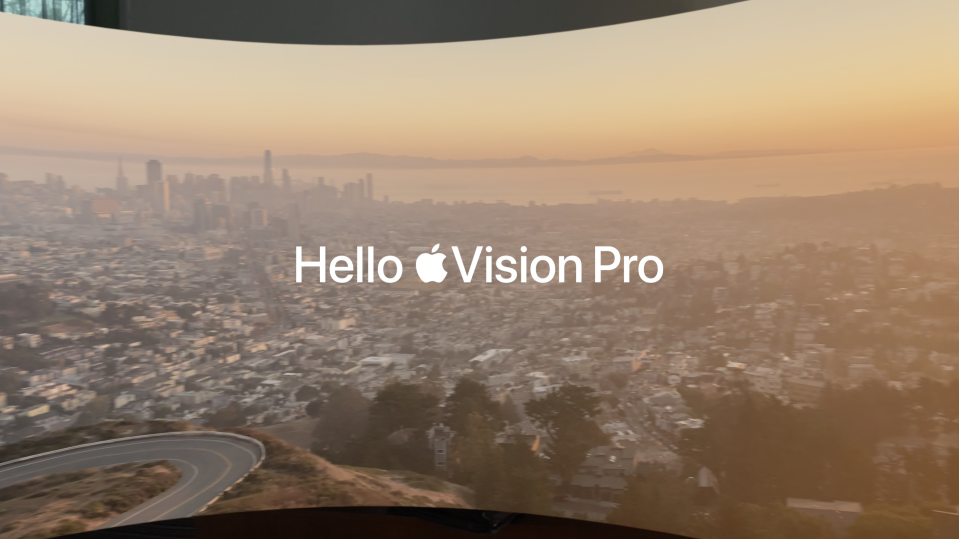
According to Apple's launch presentation during last June's WWDC keynote, the Vision Pro will cost $3,499 at launch. The headset will initially be available in the U.S. only, so we do not have pricing for other countries at this time.
For that $3,499, you get a device with 256GB of storage, a battery, a USB-C charging brick and cable, a light seal, 2 light seal cushions, a cover for the front of the headset and two band options. If you wear glasses or contacts, you'll also need to order an extra pair of lenses in order to use the Apple Vision Pro. Zeiss will make both readers ($99) and prescription lenses ($149) that attach to the Vision Pro’s interior magnetically.
Apple Vision Pro pre-orders start on January 19 at 8 a.m. EST/ 5 a.m. PST. Previously, you've been able to sign up for a notification from Apple as to when those pre-orders get underway.
As for a cheaper version of the headset, rumors of the Apple Vision Pro 2 are already starting. There was initially a Vision Pro 2 leak that described a headset that's awfully similar to its predecessor but now rumors suggest that there are as many as four new Vision headset models that could be a direct replacement for the first-generation model. Again, the Apple Vision Pro hasn't even come out yet.
But if Apple does come out with a cheaper Vision Pro that'll be good news. The current version of the Vision Pro may have serious supply chain constraints thanks to its pricey displays and they would logically be dropped from the cheaper headset. According to a rumor, Sony, which makes the headset's Micro OLED displays, can only produce 100,000 to 200,000 displays per quarter. That means it's possible Apple can only manufacture 400,000 headsets per year due to the premium displays it has chosen.
It seems this estimate of 400,000 could be right on the money. A report from Financial Times suggests that Apple's initial sales target of 1 million units in the first year has now been revised to — you guessed it — 400,000 units. That could make it nearly impossible for Apple to reach an install base of 20 million users in 5 years, which some analysts are predicting. However, that hasn't stopped Apple from reportedly projecting 10 million units sold by 2026.
Apple Vision Pro release date
Apple Vision Pro now has an official release date — February 2, according to Apple. The announcement follows multiple reports that a launch was imminent in early 2024.
As previously mentioned, at its release the Vision Pro will only be available to U.S. customers, though other countries are expected to get a rollout not too long after the U.S. launch. That global launch is now reportedly set for 2025.
Once it's released though, you'll need to head to an Apple store to get one. In Apple's FYQ4 earnings call, CEO Tim Cook said that the Vision Pro will be "in our stores only" and that "We'll be offering demos in the stores and it will be very different process than the — a normal grab-and-go kind of process."
So you heard it from the man himself. If you want to get your hands on the Apple Vision Pro, you'll need to head to your local Apple store starting February 2.
Apple Vision Pro design
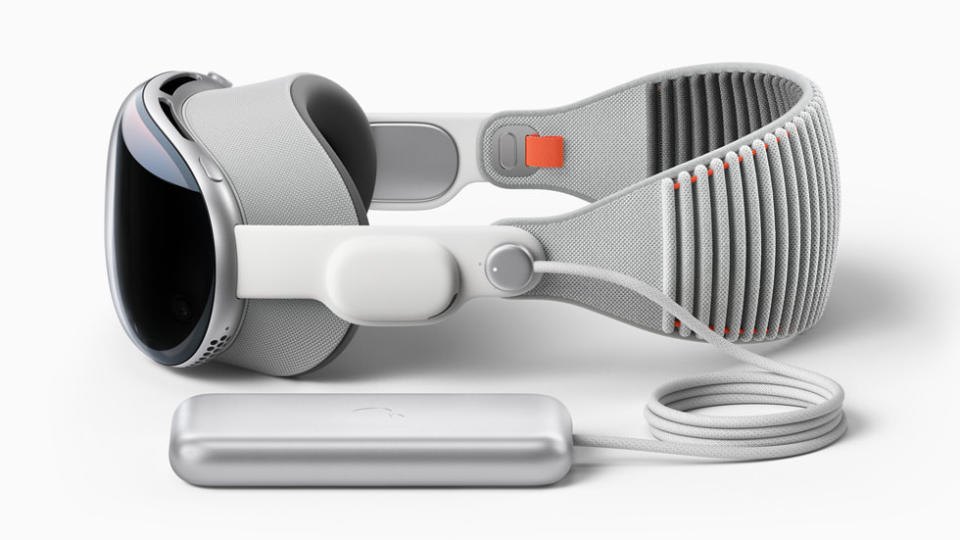
At first glance, the Apple Vision Pro doesn't look incredibly dissimilar from a traditional VR headset or even a mixed reality device like the Meta Quest Pro. But once you turn it on, there are some distinct differences.
The biggest one is that the front of the visor features a display underneath a curved pane of 3D laminated glass. This allows the Vision Pro to use EyeSight, a feature that shows others around you your eyes so they feel like they're interacting with you like they would normally.
By the way, if you want this feature, you'll want the first-generation Apple Vision Pro. While a cheaper version's future is still very much in doubt, there are rumors that one way Apple could build a low-cost Vision Pro is by ditching EyeSight. Conversely, if EyeSight doesn't appeal to you, it could be worth waiting a bit to see if a future model ditches it rather than picking up the Vision Pro right away.
This glass pane also serves as a lens for the Vision Pro's camera array, which is extensive. The Vision Pro includes 12 cameras and six microphones so that users do not need controllers to control the device. Instead, you will use a combination of eye tracking, hand gestures and voice commands.
But the front display isn't all that is crafted using Apple's typical eye for details. The mixed reality headset features a custom aluminum alloy frame that is curved to fit your face. Apple takes this focus on custom fit further by using a modular design so the Light Seal (what Meta calls a facial interface) fits to your face as perfectly as possible. The Light Seal comes in several shapes and sizes and is made of a soft fabric for improved comfort while using the Vision Pro.
Apple also continues its focus on fit with the Head Band, which is also available in a variety of sizes. It is made of a 3D knitted fabric and attaches via a simple locking mechanism at the front of the headband. It's around here that you'll also find the speakers, which Apple dubs "audio pods." These pods provide Personalized Spatial Audio that is designed to be as immersive as possible.
The Vision Pro has two buttons on the top of the headset. One is an action button that allows you to take spatial photos and videos. And for those worried about being unwittingly photographed, Apple promises that the front display will use EyeSight to signal that a photo or video is being taken. The other button is a crown similar to the Apple Watch, which can control the level of immersion you are in while wearing the headset.
One way we know this crown will be used is to engage the Vision Pro's Cinema Environments. These 13 locations will become the Vision Pro's background as you watch movies on the simulated 100-foot screen, provided you crank up the immersion on the Vision Pro's dial.
Finally, there's one last major design note. The Apple Vision Pro can be used all day when plugged in but otherwise needs an external battery to work. This battery — possibly dubbed 'Magic Battery' — lasts for about two hours and connects to the headset via a woven cable. Unfortunately, that means you'll need yet another proprietary Apple charger. What looks like a USB-C adapter was spotted attached to the headset in a WWDC developer video. However, it's unclear at this point whether the adapter (which appears to attach to the other side of the headset from the power cable) will be available to all or merely used as a developer tool.
Apple Vision Pro display
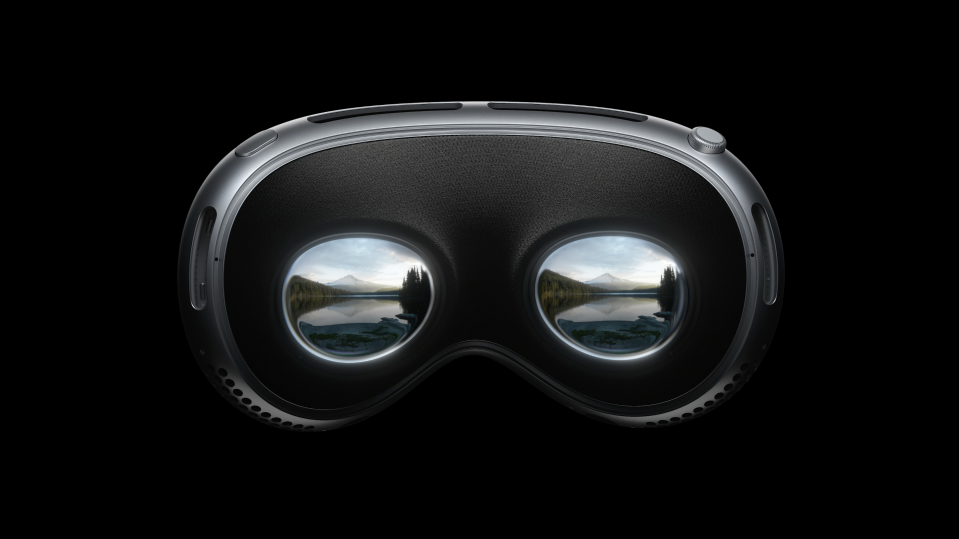
The Apple Vision Pro displays are leaps and bounds ahead of anything Meta offers so far. It features two Micro OLED 4K displays, one per eye. A leak following WWDC estimates these 4K displays will have a display resolution of 3800 x 3000 per eye once Apple reveals its official spec sheet.
Each display is the size of a postage stamp, which produces incredible pixel density. The two 4K displays combined have 23 million pixels, which Apple says is 64 times the pixel density of an iPhone. These incredible displays are a big way that the Apple Vision Pro beats the Meta Quest Pro, at least on paper.
If you want to learn more about Micro OLED technology and why it's perfectly suited for the small displays of VR headsets, check out our Micro OLED explainer to learn about how it works, the advantages and disadvantages of Micro OLED and more.
Apple says that the twin displays feature "wide color and high dynamic range" though it's unclear if that means the displays support HDR content in formats like HDR10 or Dolby Vision. And thanks to the new R1 chip developed by Apple, content will get to those displays in just 12ms. The refresh rate for 2D content is 90Hz according to Apple, with the ability to peak at 96Hz for content created at 24fps.
If you need glasses though, we do have some bad news for you. Due to its design, the Apple Vision Pro will not work with glasses. Instead, Apple is collaborating with Zeiss for optical inserts to replace your glasses while using the headset. Readers will cost $99 and prescription lenses will cost $149 on top of the regular $3,499 pricing. Zeiss launched its own site for the Apple Vision Pro inserts.
We also may have gotten a sneak peek at what the display for a future second or third Vision Pro could look like, and it's very futuristic. In a patent application, Apple laid out the possible design for a liquid display that uses a system of actuators, pumps and reservoirs to form and deform lenses within flexible and/or rigid walls.
Again, this won't be the route Apple goes with for this edition of the Vision Pro, but if they use it in the future, it could eliminate the need for the custom Zeiss inserts.
Apple Vision Pro apps and visionOS
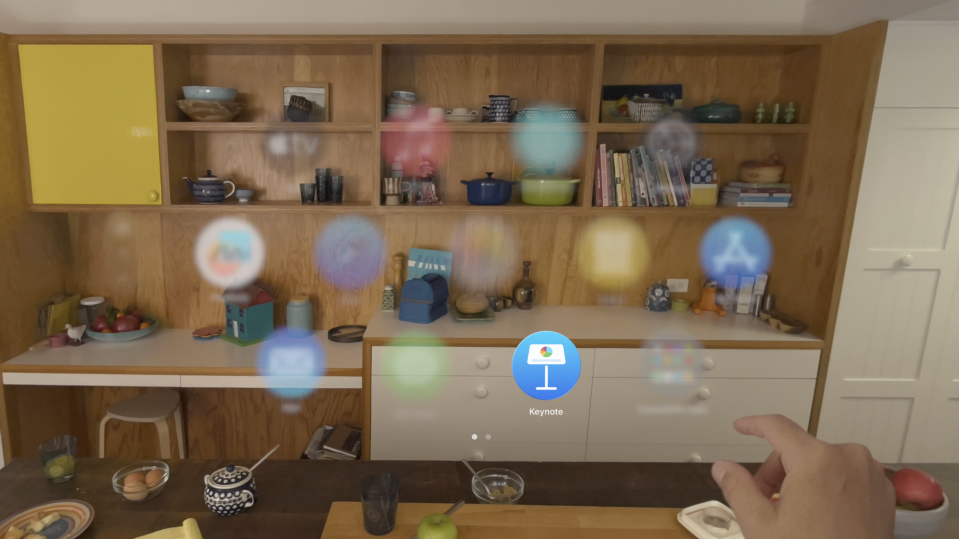
Apple Vision Pro wasn't the only new product introduced by Apple at WWDC last year. The company also showed off visionOS, a brand new operating system specifically designed for the Vision Pro. It allows developers to build apps natively for the mixed reality headset and introduces some new features as well.
The biggest new feature? EyeSight. We've talked about it already, but EyeSight could either be the coolest thing or the creepiest thing about the Vision Pro headset. It displays your eyes to the world around you or hides them if you're immersed in the headset. If you are immersed in a particular app or workflow, EyeSight also will bring you slowly out of that immersion and into the physical world when someone enters your direct field of view. As that person fades into the twin 4K displays, your eyes will simultaneously fade in on the front display of the Vision Pro.
Speaking of immersion, an alleged leak from the set of an unannounced Apple TV Plus show has shown off what looks like a camera designed for capturing 180-degree footage. As such, it's been posited that Apple could be making shows or movies that are designed for the Vision Pro and to make use of the wide field of vision the headset could provide. The first of these immersive Apple TV Plus originals could be Monarch: Legacy of Monsters, a Godzilla TV series that was reportedly shot using the 180-degree camera we had already seen one rumor about.
The Vision Pro is all about staying in the physical space as much as possible, even if you can turn the crown on the top of the headset to make yourself more immersed in the virtual world. And visionOS works on the assumption of coexisting with your physical space. It creates a 3D user interface that responds to natural light and casts shadows and allows for apps to be expanded and moved with just a hand gesture.
Reportedly, a "Visual Search" feature will let Vision Pro users get information about objects in the real world and serve up text about those items in front of their eyes. From there, they can copy and paste the text into various apps, as well as translate that text into 17 different languages.
Speaking of apps, the Apple Vision Pro should come with a surprising amount out of the box. While native visionOS apps are still relatively few and far between, the mixed reality headset works with iOS and iPad OS apps as well to provide you with a ton of options all in one App Store.
Netflix is one example of a popular service that will be skipping the native VisionOS treatment, and leaving users to watch content on the native iPad app instead.
Apple showed off a few examples of how these apps operate on the Vision Pro. Photos can be viewed in a massive display right in front of you or in a panoramic view. The Mindfulness app expands into a full-room experience for some meditative bliss. And you can watch movies and shows through Apple TV Plus and Disney Plus on a massive theatre-sized screen.
The Vision Pro may not be aimed at playing the best VR games, but that doesn't mean you can't game with it. Apple Arcade provides over 100 games — including NBA 2K — that will be playable on day one. And you can even use a Bluetooth controller to play your games since the Apple Vision Pro has no first-party controllers.
However, while Apple hasn't focused on VR games, they do have a partner in getting as many games on the platform as possible. Unity's new PolySpatial tool allows game developers to port existing VR games or create new games, both as immersive experiences or in scalable windows.
Unfortunately, this partnership could ultimately turn into a disaster for Apple due to an unforced error by Unity. Unity recently announced install fees for games using its engine and this has caused game developers to seriously reconsider if they should use Unity going forward. It's unclear if these fees will also apply to games ported to the Vision Pro through PolySpatial, but regardless it's certainly not what Apple was hoping for when it joined forces with Unity.
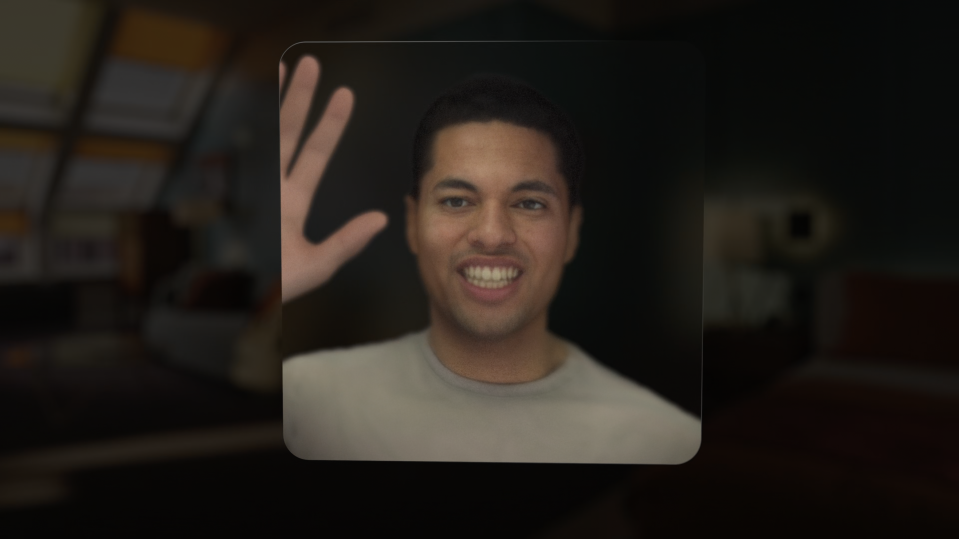
Aside from games, typical productivity apps that you use on your other Apple devices are available on the Vision Pro too. Safari is viewable in a massive display and you can expand it to see all your open tabs at once. FaceTime is there too, and you can move people's video feeds to one side of your display while keeping other apps in view.
You, however, won't be visible on FaceTime. At least, not the real version of you. Instead, the Apple Vision Pro will create a Digital Persona to represent you in FaceTime that will simulate your face and hand movements. This Digital Persona feature may also make its way onto the Apple Watch based on an Apple patent application.
But the biggest productivity upgrade? You can expand your Mac display into a larger 4K display just by looking at a compatible machine. This wirelessly beams the Mac's display to your headset, letting you view things in the same view as other visionOS apps.
With this in mind the Vision Pro is compatible with Bluetooth devices like the Magic Keyboard or Magic Trackpad, though it does have onboard tools to handle productivity — including voice and sight, and a virtual keyboard.
And if you want to work — or relax — on a plane, there's also a visionOS feature for you. Travel Mode has been spotted in the visionOS developer beta, and it is totally focused on the experience of using the Vision Pro on a plane. It does this by toning down or disabling many of the headset's awareness features to combat the fact that you're in a cramped space.

Travel Mode won't be the only unique mode that the Vision Pro gets either. According to early looks at the developer beta for visionOS, there will be a Guest Mode for the Vision Pro that allows you to lend the headset to friends and family while keeping some personal data secure.
Apple's also been awarded a patent for a "privacy cloak" feature. This potential feature allows Apple Vision Pro wearers to have private conversations in a "computer-generated reality." There's no guarantee that this feature will make it in time for the Vision Pro's launch, but it is something to keep an eye on.
There are also several features we won't get to see — at least for this generation of the Apple Vision Pro. Multiple Mac desktops displayed in the headset, FaceTime with multiple Digital Personas and access to Apple Fitness Plus are all missing features from the Vision Pro that are still planned for a second-generation headset.
If you want to see how visionOS might look, there's an unlikely source. Supernova Technologies managed to get visionOS on a Meta Quest Pro and it's a bit of a shock looking at the new OS out in the wild.
Unfortunately, looking at it is about all you can do. The apps won't work, and you'll need some tech savvy to even get this visual demo working on your own Quest Pro, so it's not the most practical thing to try out for yourself.
One other unique experience that may be coming to the Vision Pro? NBA games in mixed reality. NBA Commissioner Adam Silver has said “the league is working with Apple to bring a tech-enhanced viewing experience” to its upcoming headset.
Apple Vision Pro accessories
Now that preorders have gone live, the Vision Pro's product page has revealed the various configurations and accessories for Apple's headset. Unsurprisingly, getting all the extra trimmings with your Vision Pro will set you back a pretty penny.
Upgrading your Vision Pro's storage to 512GB sees the price jump to $3,699, and 1TB will cost $3,899. (The base model for $3,499 comes with 256GB of storage.) A travel case for on-the-go sessions will set you back $199. Or you can deck out the Vision Pro's external battery pack with a $49.95 Belkin battery holder that clips onto your belt. Meanwhile, optical inserts (because, unlike the Meta Quest, you can't wear glasses with the Vision Pro) will start at $99 for readers while prescription lenses will be $149. Both are made by Zeiss, and attach to the Vision Pro’s interior magnetically.
Check out the full list of Apple Vision Pro accessories below.
Travel case: $199
Extra battery: $199
Zeiss Optical Inserts: start at $99, can go up depending on the type of prescription
Extra light seal: $199
Belkin battery holder: $49.95
Extra solo knit band: $99
Extra dual loop band: $99
Extra charging cable: $19 for 1m cable, $29 for 2m cable
Extra power brick: $39
Apple VR/AR mixed reality headset rumored specs
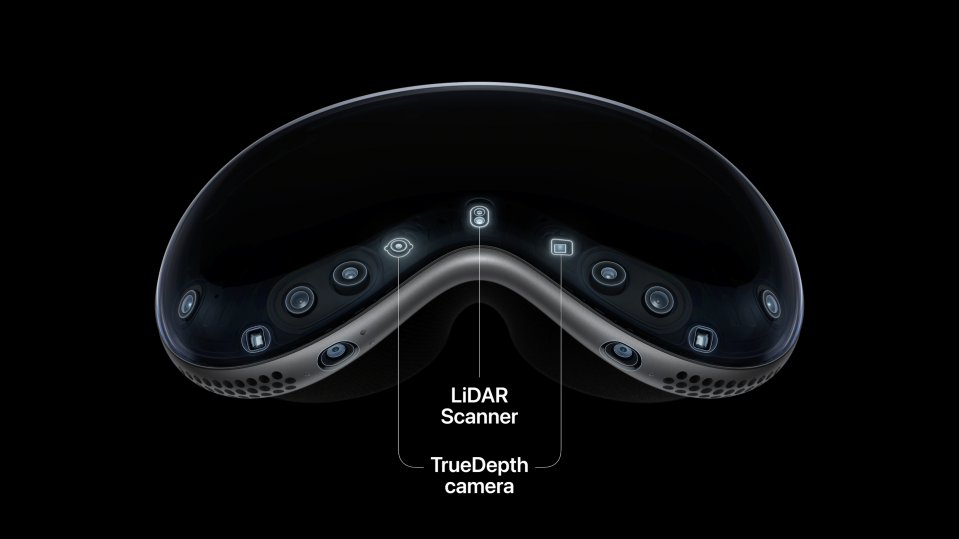
Key details about the Apple Vision Pro have emerged since its preview last year. First, let's take a look at the outside of the headset. The headset features 12 cameras, six microphones and five sensors to allow for eye tracking, hand tracking and voice commands to be all you need to control the device. Then inside the headset is a ring of LED lights that project invisible patterns onto your eyes to assist with the eye-tracking. These LED lights also power Optic ID, which is the Vision Pro's version of Face ID.
Under the hood, the Vision Pro is powered entirely by Apple silicon. An M2 chip does most of the heavy lifting, but a brand-new R1 chip handles the sensor inputs and ensures the display doesn't lag behind. Apple says the R1 chip keeps the input lag of the twin 4K Micro OLED displays at just around 12ms — on par with a lot of the best TVs.
Now that Apple's set a launch date for the headset, it's confirmed that the Apple Vision Pro will offer 256GB of storage.
Finally, Apple promises spatial audio thanks to a speaker on each side of the headset, near where it connects with your Head Band. These speakers — or audio pods — provide what Apple calls "the most advanced Spatial Audio system ever." The individually amplified drivers inside each audio pod can even be fine-tuned to deliver Personalized Spatial Audio based on your head and ears.
And it's not only the Apple Vision Pro spec sheet that matters here. Apple wants to insert the Vision Pro into its greater ecosystem of devices, so it's potentially upgrading the ultrawide-band chip in the iPhone 15 to a 7nm chip for greater power efficiency when used in concert with the Vision Pro.
Apple Vision Pro spatial video
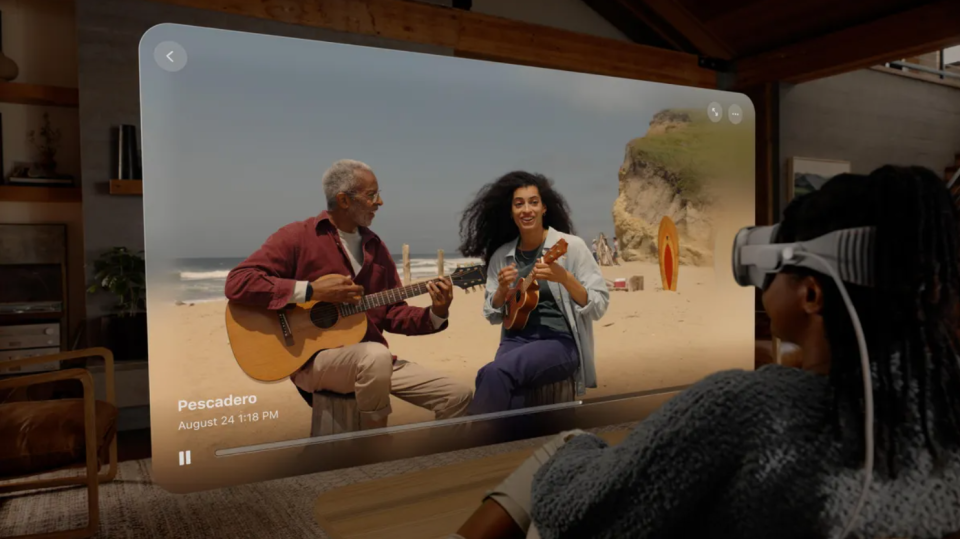
With the iOS 17.2 update released at the end of 2023, iPhone 15 Pro and iPhone 15 Pro Max users can now record spatial videos in lifelike 3D for viewing in Apple's upcoming mixed reality headset. While the full viewing experience will have to wait until the Vision Pro comes out, users can record 3D video by enabling the Spatial Video option (Settings > Camera > Formats > Video Capture).
Here's how it works: The iPhone 15 Pro uses the 13mm ultrawide and 48MP main cameras in landscape (so you'll have to hold your phone horizontally) to capture side-by-side videos that then become your own VR experience when viewed on the Vision Pro. According to the Settings app on the latest iOS 17.2 beta update, it records two 1080p, 30fps videos at once, resolving the lens and distance differences with computational photography.
Now that iOS 17.2 is here, all owners of the latest and greatest iPhones can start recording a library of personal memories to revisit in 3D on the Vision Pro. And people who've had a chance to see the spatial videos they've shot played back on an Apple Vision Pro rave about the experience.
Apple Vision Pro battery
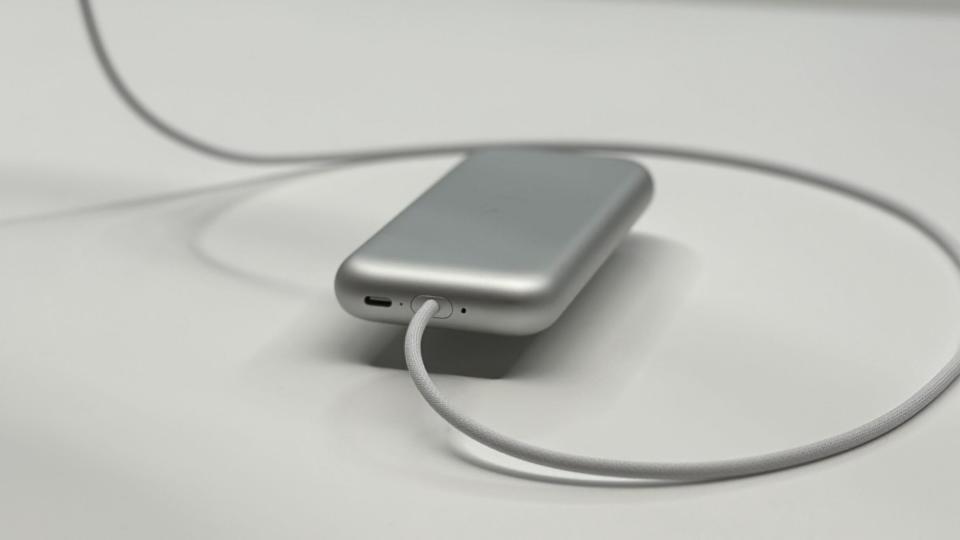
Here's arguably the biggest knock against the Apple Vision Pro, aside from the other-worldly price tag. While headsets like the Meta Quest 3 are true standalone headsets that can also tether to a PC, the Vision Pro needs to be attached to something to work.
Now thankfully, you do have options. Option one, you can plug in the headset and use the Vision Pro all day long. Unfortunately, Apple didn't say if that works if the headset is plugged into a Mac or MacBook, so the assumption is you'll need to plug straight into the nearest wall.
If that doesn't appeal to you though, there is an alternative. Apple has designed an external battery pack, possibly called 'Magic Battery,' that connects around the temple of the headset via a woven cable.
The good news? The battery is slim enough to fit in your pocket, at least according to Apple. And it may even come in multiple sizes, as one rumor tips the Vision Pro to get three different battery pack sizes.
The bad news? The only confirmed battery pack lasts just two hours and does seem to be a proprietary charger. Oh, and you may need to buy it separately, which would add to the Apple Vision Pro's $3,499 price tag.
Apple Vision Pro controls
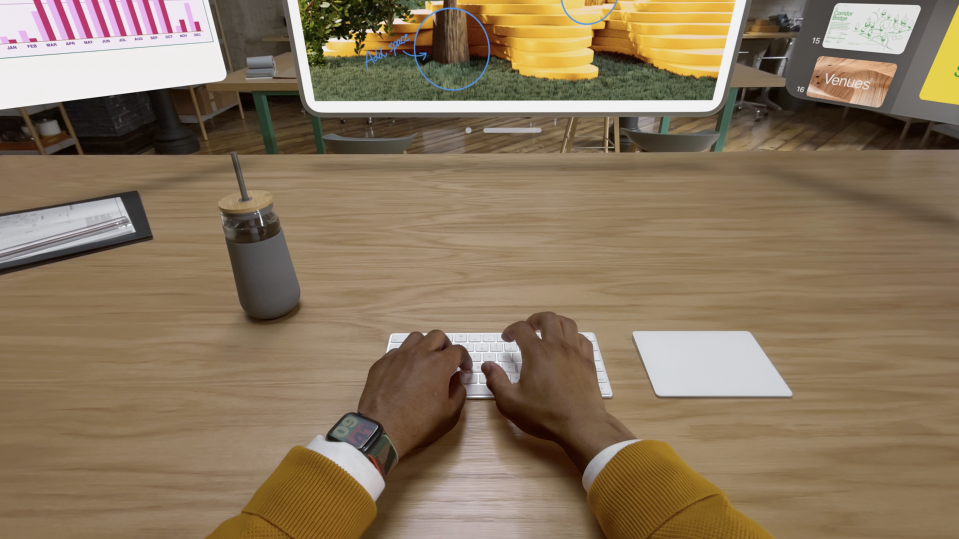
While the battery may be one of the lamer aspects of Apple's first headset, the controls are not. That's because Apple ditches controllers entirely with the Apple Vision Pro, instead using the headset's many sensors and cameras to allow you to control the device using just your eyes, hands and voice. Forcing this trend with the Vision Pro could benefit Apple, as it's rumored other VR headset developers are now pushing internally to go controller-free following the Vision Pro's unveiling.
And these intuitive controls are meant to feel natural as well. Apple says all it takes is turning your head to shift the focus of the display, or a simple tap of your fingers to simulate a mouse click. You can even keep your hands in a natural position rather than holding them in front of you when making gestures. Glancing at a search bar and speaking will even allow you to type into the search bar for easy use.
Aside from these new methods of controlling the mixed reality headset, there are two familiar features. First, Siri is back, giving you Apple's famous voice assistant right out of the box. Second, the headset does work with a range of Bluetooth products. In addition to supporting controllers like the PS5 DualSense, it also supports the Apple Magic Keyboard, Mouse and Trackpad in case you don't want to rely on hand gestures or a virtual keyboard.
Apple Vision Pro vs Apple Glass
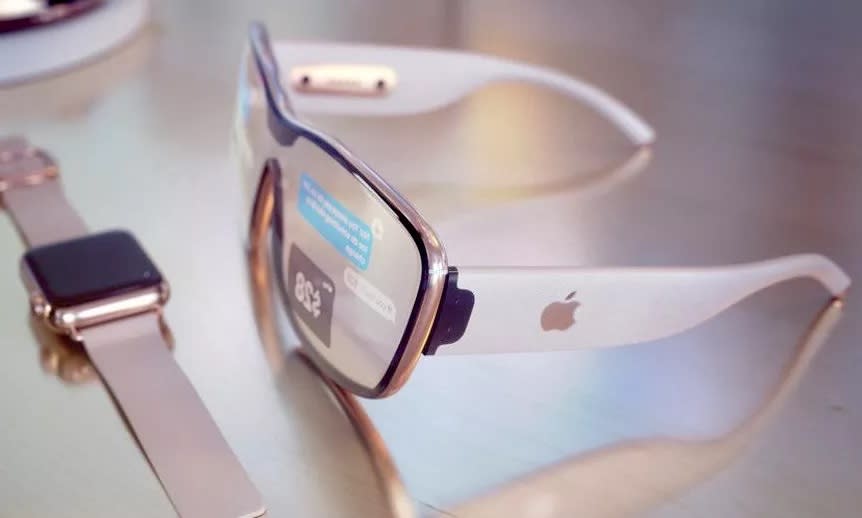
According to reports, the Apple VR/AR mixed reality headset — which we now know as the Apple Vision Pro — was designed to be a precursor to Apple Glass.
And now that we've officially seen the Vision Pro, it's clear that Apple wanted to have a true mixed reality device rather than a VR headset. The Vision Pro at times feels like an AR glasses copycat, particularly with features such as EyeSight that allow others to see your eyes while you're using the Vision Pro.
Based on everything we've heard, Apple wants the Apple Glass to look and act like an ordinary lightweight pair of glasses rather than adopt the Vision Pro's approach. That means glasses that are able to project information, and presumably imagery, onto the lenses. Unfortunately, Apple Glasses may not arrive for a long time, with Apple reportedly delaying the project due to technical challenges.
Still not sure what the difference between mixed reality, augmented reality and virtual reality actually is? We have an explainer that tells you exactly what mixed reality is and what Microsoft, Meta and Apple have planned for it.
Apple Vision Pro vs Meta Quest 3
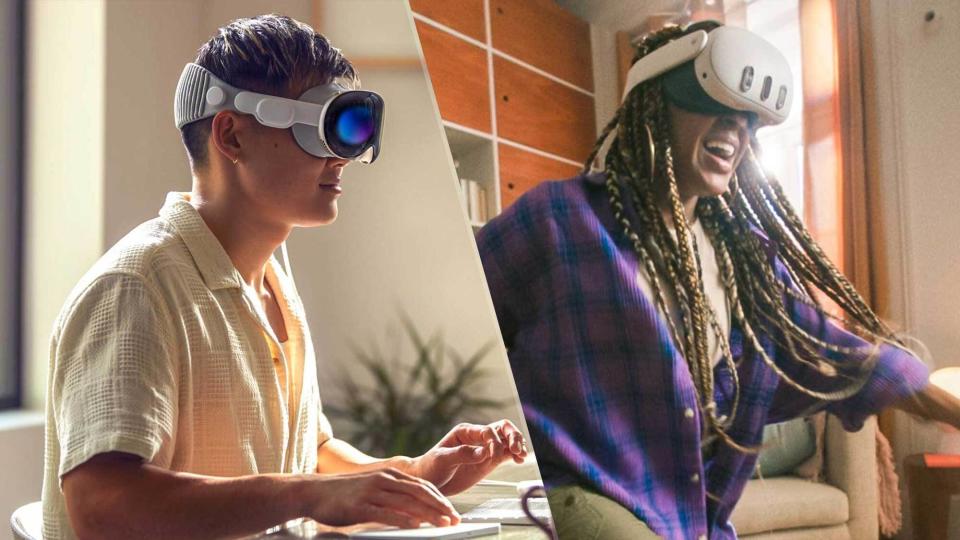
Both Apple and Meta have announced new headsets touting mixed reality features, but the two headsets are definitely different. Granted, that should be expected when the Apple Vision Pro is nearly seven times the price of the Meta Quest 3, but it's more than that. Both headsets tackle the issue of experiencing mixed reality in notably different ways, and each makes a case for being the better headset for most people. Check out our Apple Vision Pro versus Meta Quest 3 face-off for the full breakdown.
Apple Vision Pro vs Meta Quest Pro
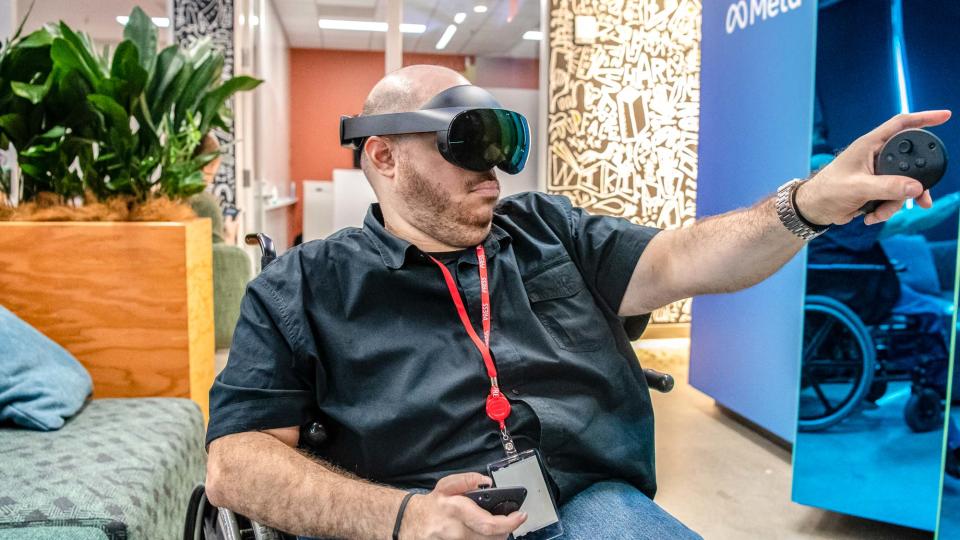
The Meta Quest 3 isn't the only Meta headset that Apple has to contend with. The Meta Quest Pro is also a mixed reality headset, with a more professional user base that will definitely be interested in the Apple Vision Pro as an alternative.
And unfortunately for the Quest Pro, the Apple headset is the clear winner between the two — as long as you can stomach the $2,499 price difference. Still, we found seven ways Apple Vision Pro beats the Meta Quest Pro, from superior specs to a better software ecosystem for productivity.
However, the next Quest Pro could be able to give the Vision Pro a run for its money. A new report alleges that LG and Meta have teamed up to make Meta's next "Pro" VR headset. This headset is rumored to cost $2,000 and is currently tipped for a 2025 release date.
